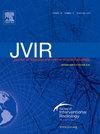Limited Effectiveness in Early Human Clinical Experience with Pulsed Electrical Field Ablation
IF 2.6
3区 医学
Q2 PERIPHERAL VASCULAR DISEASE
Journal of Vascular and Interventional Radiology
Pub Date : 2025-02-01
DOI:10.1016/j.jvir.2024.10.033
引用次数: 0
Abstract
Purpose
To evaluate oncological outcomes, abscopal effect, and adverse events (AEs) of pulsed electrical field (PEF) ablation of tumors in the chest, abdomen, and pelvis.
Materials and Methods
PEF ablations performed at an academic medical center between May 2023 and January 2024 were retrospectively analyzed. Eleven patients (4 males and 7 females; age, 58 years ± 19) underwent 11 PEF sessions targeting 13 tumors (lung metastasis from solitary fibrous tumor [n = 3] and colorectal carcinoma (CA) [n = 1], osteosarcoma pleural metastases [n = 2], hepatocellular CA [n = 2], liver metastasis from colorectal CA [n = 1] and leiomyosarcoma [n = 1], metastatic melanoma to the pancreas [n = 1], metastatic retroperitoneal lymph node from endometrial CA [n = 1], and recurrence of endometrial CA in the vaginal cuff [n = 1]) with the goal of complete coverage (n = 11/13) or debulking (n = 2/13). The mean tumor diameter was 1.9 cm (SD ± 1.0; range, 0.4–3.3 cm). Cross-sectional imaging follow-up was 5.3 months (SD ± 2.2; range, 1.9–7.9 months). Oncological outcomes, abscopal effect, and AEs categorized according to the Society of Interventional Radiology (SIR) guidelines were analyzed.
Results
Of 11 tumors that underwent ablation for complete coverage, complete coverage was achieved for 1 (9%), and residual was detected in 9 (81%). Ten (91%) of 11 patients showed either residual, local, or distant progression within a median of 3 months. No abscopal effect was observed. There were 2 mild and 2 severe AEs.
Conclusions
PEF ablation showed a low rate of complete coverage (9%) and a high rate (91%) of residual, local, or distant progression. No abscopal effect was observed in any patient within a median of 5.1 months after the ablation.

脉冲电场消融术的早期人体临床经验效果有限。
目的:评估胸部、腹部和盆腔肿瘤的脉冲电场(PEF)消融术的肿瘤学结果、腹腔效应和不良事件:回顾性分析了 2023 年 5 月至 2024 年 1 月期间在一家学术医疗中心进行的脉冲电场消融术。11 名患者(男/女:4/7,年龄:58 ± 19)接受了 11 次 PEF 消融术:11名患者(男/女:4/7,年龄:58 ± 19)接受了11次PEF消融术,针对13个肿瘤(肺转移瘤(3个)和结直肠癌(CA)(1个)、骨肉瘤胸膜转移瘤(2个)、肝细胞CA(2个)、结直肠癌肝转移瘤(1个)和子宫肌瘤(1个))、子宫内膜癌腹膜后淋巴结转移(1例)、阴道袖带子宫内膜癌复发(1例)),目标是完全覆盖(11/13)或切除(2/13)。肿瘤平均直径为 1.9 ± 1.0 厘米(0.4 - 3.3 厘米)。横断面成像随访时间为 5.3 ± 2.2 个月(范围为 1.9 - 7.9 个月)。报告了肿瘤学结果、腹水效应以及根据 SIR 指南分类的不良事件:在接受消融术以实现完全覆盖的 11 例肿瘤中,1 例(9%)实现了完全覆盖,9 例(81%)检测到残留。11 名患者中有 10 名(91%)在中位 3 个月内出现残留、局部或远处进展。未观察到腹水效应。有 2 例轻微和 2 例严重不良反应:PEF消融术的完全覆盖率低(9%),残留、局部或远处进展率高(91%)。消融术后中位 5.1 个月内未观察到腹腔效应。
本文章由计算机程序翻译,如有差异,请以英文原文为准。
求助全文
约1分钟内获得全文
求助全文
来源期刊
CiteScore
4.30
自引率
10.30%
发文量
942
审稿时长
90 days
期刊介绍:
JVIR, published continuously since 1990, is an international, monthly peer-reviewed interventional radiology journal. As the official journal of the Society of Interventional Radiology, JVIR is the peer-reviewed journal of choice for interventional radiologists, radiologists, cardiologists, vascular surgeons, neurosurgeons, and other clinicians who seek current and reliable information on every aspect of vascular and interventional radiology. Each issue of JVIR covers critical and cutting-edge medical minimally invasive, clinical, basic research, radiological, pathological, and socioeconomic issues of importance to the field.

 求助内容:
求助内容: 应助结果提醒方式:
应助结果提醒方式:


